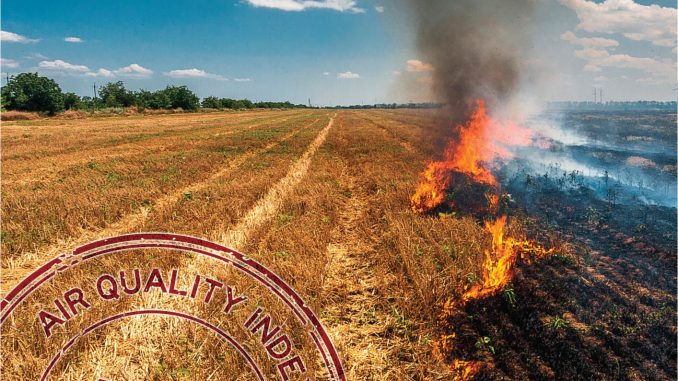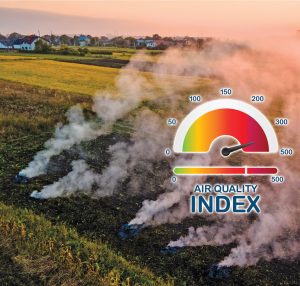
By Devangshu Datta
Stubble burning across north India, especially in Punjab and Haryana, is a primary cause of high air pollution in the winter. There are economic reasons for this practice. It is literally a quick and dirty way to clear the fields for the next crop, post-harvest. It emits toxic pollutants with harmful gases such as carbon monoxide and methane, as well as carcinogenic polycyclic aromatic hydrocarbons and volatile organic compounds. These pollutants affect air quality and people’s health by forming a thick blanket of smog. Monitoring agencies say the practice contributes to 45 per cent of NCR’s air pollution during the critical period of October-November.
Simply outlawing the practice has not worked. Around 20 million tonnes (mt) of stubble is burnt in Haryana and Punjab during October and November when farmers clear their fields. Farmers in western Uttar Pradesh, Rajasthan, Madhya Pradesh and the NCR also burn stubble. NASA satellite imagery showed 57,000 fires across Punjab and Haryana in the first fortnight of November 2021.
The National Green Tribunal banned the practice across Delhi, Punjab, Rajasthan, Haryana and Uttar Pradesh in 2015. But the ban has never been properly enforced due to the political strength of the farmers’ lobby. In 2021, the ban was removed and the practice was decriminalised.
Farmers may be induced to stop this method of clearing the fields if there is an incentive to do so, and there have been attempts to come up with policies that will encourage farmers to choose alternative practices. One scheme involves the use of crop residue management machinery, but this requires additional expenses on part of the farmers and there has only been moderate uptake of this scheme. Another incentive that is being pushed by utilising biomass for power generation. Thermal power plants, which normally burn coal, are mandated to replace some proportion of coal with biomass. This scheme has shown a positive impact and if driven by political will, it could result in a significant reduction in stubble burning.
The concept is that biomass can be derived from agricultural residue and turned into dense bricks or pellets. Sometimes a process of torrefaction is used to dry and compact the biomass before it is pelletised. This makes biomass dense and hydrophobic – torrefacted pellets repel water – and hence, easier to store or transport. Non-torrefacted pellets are more susceptible to moisture. Biomass pellets can be co-fired in coal thermal plants – the biomass pellets can be used to replace coal to some extent. If the plant is well designed and the co-firing is well implemented, the cogeneration output is equivalent.
Biomass usage has other advantages. There is a reduction in coal usage – which in turn reduces CO2 emissions. It may save costs if coal becomes more expensive than biomass pellets. Biomass is a renewable resource and if it is collected for co-firing, stubble burning may be greatly reduced. This usage may also result in income generation for farmers, and job creation via the supply chain of biomass collection and pellet manufacture.

In October 2021, the Ministry of Power (MoP) amended an existing policy on biomass usage. The ministry made it mandatory for coal-based thermal plants to use at least 5 per cent biomass pellets made primarily of agro-residue (assuming it is technically feasible). The policy will be in force for 25 years or till the end of the useful life of the plant, whichever is earlier.
The policy is designed to encourage pellet usage to be raised to 10 per cent eventually. Generators will have to sign contracts with pellet suppliers for a minimum period of seven years to avoid delays in annual awards of contracts. This is meant to encourage the creation of long-term supply chains. Increases in costs in terms of energy charge rate (ECR) will be passed through for certain categories of plants, while plants in other categories could claim compensation for increase in ECR due to changes in relevant legal provisions. Discoms could also meet their renewable purchase obligations by buying units generated by co-firing.
The Sustainable Agro Mission on Use of Agro Residue in Thermal Power Plants, or SAMARTH, was established by the MoP for addressing the challenges of replacing stubble burning with biomass cogeneration. One of its purposes is to provide revenue streams for farmers and small business owners.
A year down the line, quite a lot of progress is visible on this front. SAMARTH says that 35 power plants started using biomass in 2021-22 and 39 plants were using it by 2022-23 (as of July 24, 2022) versus only eight in 2020-21. It is estimated that 83,066 tonnes of biomass has been co-fired, totalling a generation of 55,390 MW. Collectively this has contributed to a 0.1 mt reduction in the carbon dioxide footprint of thermal power generation. In the NCR alone, 22,696 tonnes of biomass has been co-fired, out of which 95 per cent was undertaken by NTPC.
Since the ministry estimates that 230 mt of surplus biomass is available annually, the current cogeneration levels have only scratched the surface. The initial target of 5 per cent cogeneration has not yet been achieved. But many power plants have issued long-term tenders for pellet supplies and plants are being encouraged to look at short-term sources as well.
Measures for further increasing biomass usage in thermal power generation could involve both the carrot and the stick. The environment ministry has advocated strict action against plants that fail to take steps to curb emissions and against those not co-firing the mandated quantity of biomass. There may be penal provisions imposed on such power plants.
All plants in the NCR have been instructed to install biomass pellet manufacturing plants (torrefied/non-torrefied) on their premises. This includes private generators. Putting up pellet manufacturing facilities via consortium is also allowed. Non-compliance could lead to penalties being strictly imposed. The power ministry has said it would consider a reduction in coal supply to plants that do not comply with its policy.
The Ministry of Agriculture claims it has distributed Rs 6 billion worth of stubble collection machinery to the hiring centres of state governments. The scheme is being monitored to ensure it reaches the intended beneficiaries and to see that machines for stubble collection are made available in the vicinity of power plants.
The MoP has also initiated various activities and measures to encourage biomass co-firing. These include the creation of a long-term model contract for pellet supply, development of a database of biomass stakeholders, and research and development (R&D) for testing of biomass. Many offline and online training and awareness programmes for farmers, pellet manufacturers and power plant officials have been held. This is apart from media campaigns to stop stubble burning.

On the pellet procurement front, tenders have been floated by several power plants. Over 100 mt of biomass is at various stages of tendering. While orders have already been placed for over 4 mt under tenders, tendering is ongoing for 106 mt.
Capital support for pellet manufacturing plants as well as torrefaction plants in the NCR could provide a boost. Non-torrefied plants may receive a one-time support of Rs 140,000 per 100 kg of production capacity, subject to a ceiling of Rs 7 million. Torrefied plants may receive a one-time capital support of Rs 280,000 per 100 kg of production capacity, subject to a ceiling of Rs 14 million. The Central Pollution Control Board will oversee this scheme, which envisages pellet manufacture via the EPC route.
In May 2022, NTPC issued requests for proposal to provide an integrated platform for start-ups that could help in the development of a biomass ecosystem. The platform will be managed by NETRA, the R&D wing of NTPC, for production of torrefied biomass pellets.
There are several issues to be considered. The process of manufacturing pellets causes some pollution since torrefaction involves pyrolysis. Burning biomass pellets also leads to emission of CO2 and other harmful gases and particles. That impact has to be compared to the pollution caused by coal burning (and the coal mining supply chain), plus the pollution and other harmful environmental impacts currently caused by widespread stubble burning.
There are studies that claim pellets may cause more pollution per unit of power generation than the equivalent coal. However, it can also be argued that the absorption of CO2 by trees offsets a greater quantum of emissions than in the case of coal burning. The fact that trees and plants absorb CO2 is indeed the reason why biomass burning is considered a renewable, green resource. If waste, surplus biomass is used rather than living trees (as in the US and Sweden), the impact is lessened.
Once the biomass industry gets traction in India, care will have to be taken to ensure that only waste agro-residue is being used. A 2018 study indicated that up to 6 per cent of India’s total power generation could come from surplus biomass pellets by 2030-31. However, and this could be crucial, the cost per unit may be higher than that of imported coal.
A well-crafted policy would need to address these challenges as the concept develops scale. The pollution data this year would be indicative of how effective the policy is in terms of reducing stubble burning, thus reducing the toxicity of the environment.



